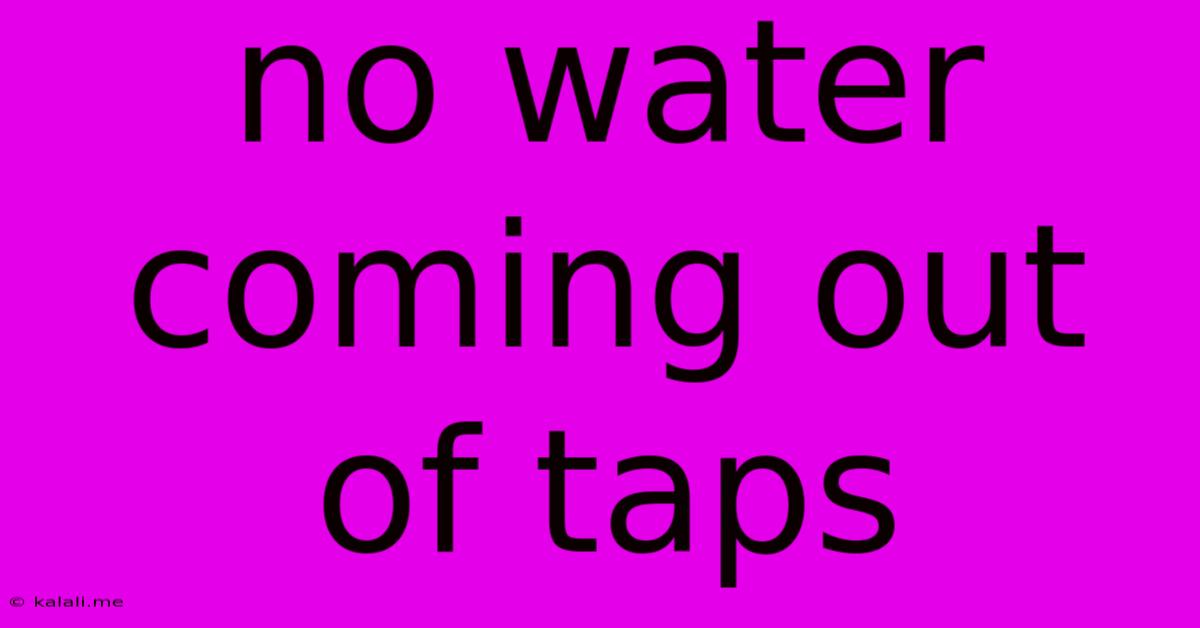No Water Coming Out Of Taps
Kalali
May 21, 2025 · 4 min read

Table of Contents
No Water Coming Out of Your Taps? Troubleshooting Guide
Meta Description: Experiencing no water pressure or flow from your taps? This comprehensive guide explores common causes, from simple fixes like checking your main water supply to more complex issues requiring a plumber. Learn how to diagnose and resolve the problem yourself, saving time and money.
Having no water coming from your taps is a frustrating problem, but thankfully, it's often solvable with some basic troubleshooting. This guide will walk you through the most common causes and solutions, helping you determine whether you can fix it yourself or need to call a professional plumber.
1. Check Your Main Water Supply
The simplest explanation is often the correct one. Before diving into complex plumbing issues, ensure your main water supply isn't shut off. This valve, usually located near your water meter or inside your house (often near the water heater), controls the water flow to your entire home. Check if it's fully open. If it's partially closed or completely off, turn it fully open. If you're unsure where your main water shutoff valve is located, check your home's manual or consult a plumber.
2. Low Water Pressure Issues
Sometimes, the water isn't completely off, but the pressure is significantly reduced. This can point towards several problems:
- Water main break: A break in the main water line supplying your neighborhood can lead to low or no water pressure affecting multiple homes. Check with your neighbors; if they're experiencing similar issues, contact your local water utility company.
- Clogged pipes: Mineral buildup, sediment, or debris can restrict water flow within your pipes. This is more likely if the low pressure is affecting multiple taps.
- Faulty pressure regulator: This device maintains consistent water pressure in your home. A malfunctioning regulator can cause either low pressure or high pressure problems.
3. Individual Tap Issues
If only one or two taps are affected, the problem is likely localized to that specific tap or the plumbing leading to it. Consider these possibilities:
- Clogged aerator: The aerator, a small screen at the end of your faucet, often gets clogged with debris, reducing water flow. Unscrew the aerator (usually by hand), clean it thoroughly under running water, and reinstall.
- Debris in the tap: Sometimes, small particles can obstruct the faucet's internal mechanisms. Try running the tap for an extended period; sometimes, the obstruction will clear itself.
- Faulty cartridge or valve: For more persistent issues, the internal cartridge or valve within the tap might be damaged or worn. This often requires replacing the cartridge, a task that varies in difficulty depending on the tap's design. A plumber may be needed for complex tap replacements.
- Frozen pipes: In colder climates, frozen pipes can completely block water flow. This often requires thawing the pipe; in severe cases, the pipe might need repair or replacement.
4. Water Heater Issues
If hot water isn't flowing but cold water is, the problem may reside within your water heater. Consider these:
- Empty tank: While less common with modern water heaters, an empty or nearly empty tank can reduce or eliminate hot water flow. Check the water level indicator on your tank (if applicable).
- Pilot light issues (for gas heaters): If your gas water heater is not igniting, there will be no hot water. Consult your water heater's manual or contact a professional for assistance.
- Heating element failure (for electric heaters): A faulty heating element prevents the water from being heated, resulting in only cold water flowing. This usually requires professional repair or replacement.
5. When to Call a Plumber
While many of these issues can be tackled with simple DIY solutions, it's important to know when to call a qualified plumber:
- Persistent low water pressure affecting multiple taps: This could indicate a more serious problem with your main water line.
- No water from any tap, even after checking the main water supply: This suggests a significant plumbing issue requiring professional assessment.
- You're uncomfortable undertaking DIY repairs: Plumbing repairs can be complex, and it's always better to err on the side of caution and seek professional help if you're unsure.
- Suspected frozen pipes: Improper thawing can lead to further damage.
By following these steps, you can effectively troubleshoot the lack of water coming from your taps. Remember safety first; if you're uncertain about any repair, contact a licensed plumber.
Latest Posts
Latest Posts
-
Where Is Decking Height Measured From
May 21, 2025
-
Imessage Not Working For One Contact
May 21, 2025
-
How Long Do Fridges Take To Get Cold
May 21, 2025
-
Can U Get Ink Poisoning From A Pen
May 21, 2025
-
Can A Queen Move Like A Knight
May 21, 2025
Related Post
Thank you for visiting our website which covers about No Water Coming Out Of Taps . We hope the information provided has been useful to you. Feel free to contact us if you have any questions or need further assistance. See you next time and don't miss to bookmark.